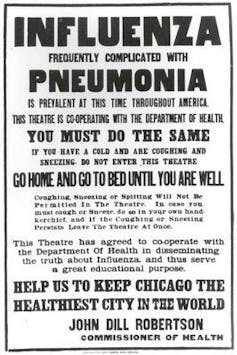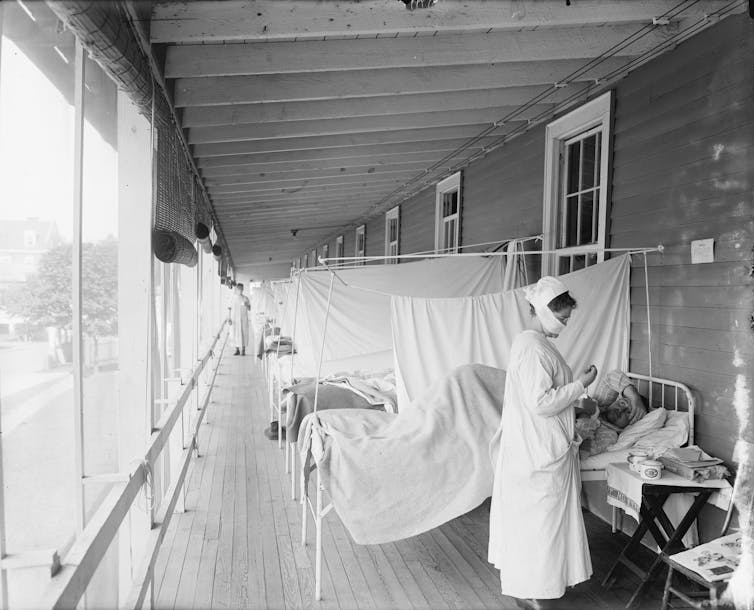
It was the greatest pandemic in history - but how ‘Spanish’ was the 1918 flu?
Many of us still get our basic facts wrong.

Soldiers from Fort Riley, Kansas, ill with Spanish influenza at a hospital ward at Camp Funston. US Army photo via Wikipedia
This year marks the 100th anniversary of the great influenza pandemic of 1918. Between 50 and 100 million people are thought to have died, representing as much as 5 percent of the world’s population. Half a billion people were infected.
Especially remarkable was the 1918 flu’s predilection for taking the lives of otherwise healthy young adults, as opposed to children and the elderly, who usually suffer most. Some have called it the greatest pandemic in history.
The 1918 flu pandemic has been a regular subject of speculation over the last century. Historians and scientists have advanced numerous hypotheses regarding its origin, spread and consequences. As a result, many of us harbor misconceptions about it.
By correcting these 10 myths, we can better understand what actually happened and learn how to prevent and mitigate such disasters in the future.
1. The pandemic originated in Spain
No one believes the so-called “Spanish flu” originated in Spain.
The pandemic likely acquired this nickname because of World War I, which was in full swing at the time. The major countries involved in the war were keen to avoid encouraging their enemies, so reports of the extent of the flu were suppressed in Germany, Austria, France, the United Kingdom and the U.S. By contrast, neutral Spain had no need to keep the flu under wraps. That created the false impression that Spain was bearing the brunt of the disease.
In fact, the geographic origin of the flu is debated to this day, though hypotheses have suggested East Asia, Europe and even Kansas.
2. The pandemic was the work of a ‘super-virus’

The 1918 flu spread rapidly, killing 25 million people in just the first six months. This led some to fear the end of mankind, and has long fueled the supposition that the strain of influenza was particularly lethal.
However, more recent study suggests that the virus itself, though more lethal than other strains, was not fundamentally different from those that caused epidemics in other years.
Much of the high death rate can be attributed to crowding in military camps and urban environments, as well as poor nutrition and sanitation, which suffered during wartime. It’s now thought that many of the deaths were due to the development of bacterial pneumonias in lungs weakened by influenza.
3. The first wave of the pandemic was most lethal
Actually, the initial wave of deaths from the pandemic in the first half of 1918 was relatively low.
It was in the second wave, from October through December of that year, that the highest death rates were observed. A third wave in spring of 1919 was more lethal than the first but less so than the second.
Scientists now believe that the marked increase in deaths in the second wave was caused by conditions that favored the spread of a deadlier strain. People with mild cases stayed home, but those with severe cases were often crowded together in hospitals and camps, increasing transmission of a more lethal form of the virus.
4. The virus killed most people who were infected with it
In fact, the vast majority of the people who contracted the 1918 flu survived. National death rates among the infected generally did not exceed 20 percent.
However, death rates varied among different groups. In the U.S., deaths were particularly high among Native American populations, perhaps due to lower rates of exposure to past strains of influenza. In some cases, entire Native communities were wiped out.
Of course, even a 20 percent death rate vastly exceeds a typical flu, which kills less than one percent of those infected.
5. Therapies of the day had little impact on the disease
No specific anti-viral therapies were available during the 1918 flu. That’s still largely true today, where most medical care for the flu aims to support patients, rather than cure them.
One hypothesis suggests that many flu deaths could actually be attributed to aspirin poisoning. Medical authorities at the time recommended large doses of aspirin of up to 30 grams per day. Today, about four grams would be considered the maximum safe daily dose. Large doses of aspirin can lead to many of the pandemic’s symptoms, including bleeding.
However, death rates seem to have been equally high in some places in the world where aspirin was not so readily available, so the debate continues.
6. The pandemic dominated the day’s news
Public health officials, law enforcement officers and politicians had reasons to underplay the severity of the 1918 flu, which resulted in less coverage in the press. In addition to the fear that full disclosure might embolden enemies during wartime, they wanted to preserve public order and avoid panic.
However, officials did respond. At the height of the pandemic, quarantines were instituted in many cities. Some were forced to restrict essential services, including police and fire.
7. The pandemic changed the course of World War I
It’s unlikely that the flu changed the outcome of World War I, because combatants on both sides of the battlefield were relatively equally affected.
However, there is little doubt that the war profoundly influenced the course of the pandemic. Concentrating millions of troops created ideal circumstances for the development of more aggressive strains of the virus and its spread around the globe.

8. Widespread immunization ended the pandemic
Immunization against the flu as we know it today was not practiced in 1918, and thus played no role in ending the pandemic.
Exposure to prior strains of the flu may have offered some protection. For example, soldiers who had served in the military for years suffered lower rates of death than new recruits.
In addition, the rapidly mutating virus likely evolved over time into less lethal strains. This is predicted by models of natural selection. Because highly lethal strains kill their host rapidly, they cannot spread as easily as less lethal strains.
9. The genes of the virus have never been sequenced
In 2005, researchers announced that they had successfully determined the gene sequence of the 1918 influenza virus. The virus was recovered from the body of a flu victim buried in the permafrost of Alaska, as well as from samples of American soldiers who fell ill at the time.
Two years later, monkeys infected with the virus were found to exhibit the symptoms observed during the pandemic. Studies suggest that the monkeys died when their immune systems overreacted to the virus, a so-called “cytokine storm.” Scientists now believe that a similar immune system overreaction contributed to high death rates among otherwise healthy young adults in 1918.
10. The 1918 pandemic offers few lessons for 2018
Severe influenza epidemics tend to occur every few decades. Experts believe that the next one is a question not of “if” but “when.”
While few living people can recall the great flu pandemic of 1918, we can continue to learn its lessons, which range from the commonsense value of handwashing and immunizations to the potential of anti-viral drugs. Today we know more about how to isolate and handle large numbers of ill and dying patients, and we can prescribe antibiotics, not available in 1918, to combat secondary bacterial infections. Perhaps the best hope lies in improving nutrition, sanitation and standards of living, which render patients better able to resist the infection.
Richard Gunderman, Chancellor's Professor of Medicine, Liberal Arts, and Philanthropy, Indiana University
This article was originally published on The Conversation. Read the original article.

January 17, 2018
If there is one thing the nightly shaming of sexual harassment perpetrators has taught us it is that many girls and young women live to regret sexual experiences they were either ambivalent about at the time they occurred, being unsure of their own feelings, or simply too scared to reject or report assaults.
Reading today’s important article by Dr John Whitehall about the hundreds of children being referred for professional help for gender dysphoria, and the predilection of therapists for putting them on the sex change track, one foresees another and even more sensational debacle up ahead when they have lived to regret such drastic interventions in their lives – that is, those who have not become suicide statistics in the meantime.
Dr Whitehall is Professor of Paediatrics at Western Sydney University. In his article he sets out facts about the seriously negative effects of drug and surgical interventions that those administering them must know, but have never put before the Australian Family Court. And now that particular court has washed its hands of the matter, they never will. Read the article, and be informed, if not shocked.
Plus: The movie that abortion-friendly media (Facebook?) don’t want to materialise: Roe V Wade. Perhaps you can give the makers a hand.
Reading today’s important article by Dr John Whitehall about the hundreds of children being referred for professional help for gender dysphoria, and the predilection of therapists for putting them on the sex change track, one foresees another and even more sensational debacle up ahead when they have lived to regret such drastic interventions in their lives – that is, those who have not become suicide statistics in the meantime.
Dr Whitehall is Professor of Paediatrics at Western Sydney University. In his article he sets out facts about the seriously negative effects of drug and surgical interventions that those administering them must know, but have never put before the Australian Family Court. And now that particular court has washed its hands of the matter, they never will. Read the article, and be informed, if not shocked.
Plus: The movie that abortion-friendly media (Facebook?) don’t want to materialise: Roe V Wade. Perhaps you can give the makers a hand.
 Carolyn Moynihan
Carolyn Moynihan Deputy Editor,
MERCATORNET
Not so smart: how our phones can come between us
By Cecilia Galatolo
And how a little child can teach us a lesson about this.
Read the full article
Read the full article
Producers tackle Hollywood bias on abortion with film on Roe v. Wade
By Michael Cook
A daring drama about the history behind the landmark Supreme Court case
Read the full article
Read the full article
It was the greatest pandemic in history - but how ‘Spanish’ was the 1918 flu?
By Richard Gunderman
Many of us still get our basic facts wrong.
Read the full article
Read the full article
Gone is protection by the Family Court for children confused over gender
By John Whitehall
Ideology has triumphed over science.
Read the full article
Read the full article
Africa in 2017: two steps forward, one backward
By Mathew Otieno
The democratic impulse persists, in spite of all setbacks.
Read the full article
Read the full article
Team Baby: How you and your infant can both get good sleep
By Ida Gazzola
Two mothers of large families share their invaluable experience.
Read the full article
Read the full article
The suffering of surrogacy: A veteran feminist spells it out
By Selena Ewing
Why are we committing such fraud yet again?
Read the full article
Read the full article
Is a child a gift or an entitlement?
By John M. Grondelski
A child is a precious gift that does not come with a returns policy.
Read the full article
Read the full article
MERCATORNET | New Media Foundation
Suite 12A, Level 2, 5 George Street | North Strathfield NSW 2137 | AU | +61 2 8005 8605













































No hay comentarios:
Publicar un comentario